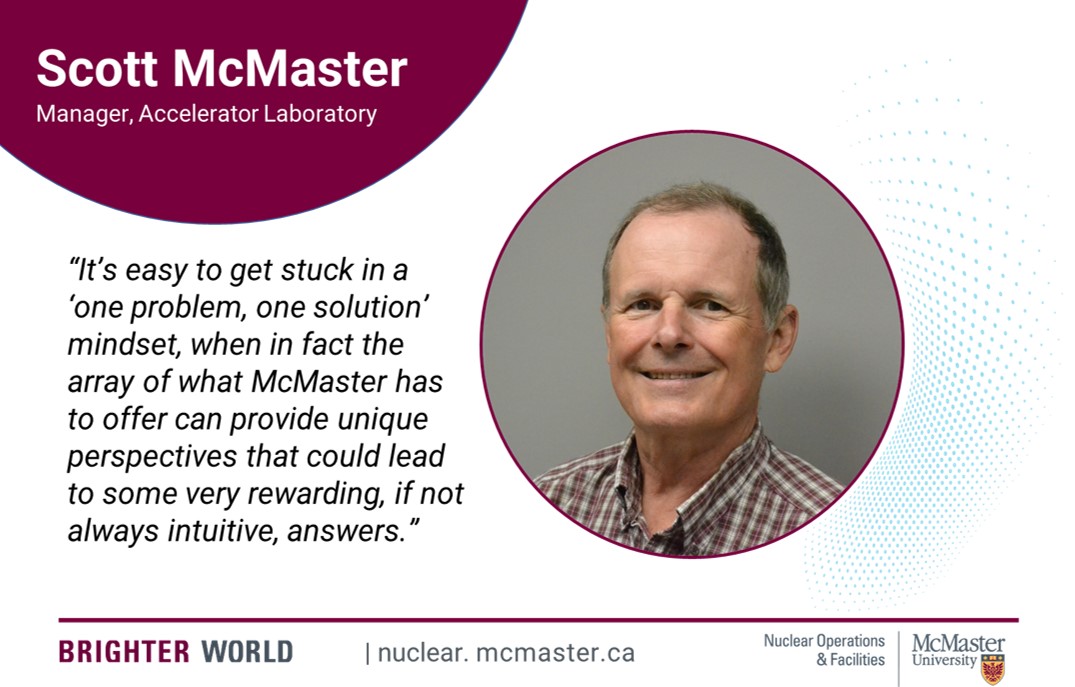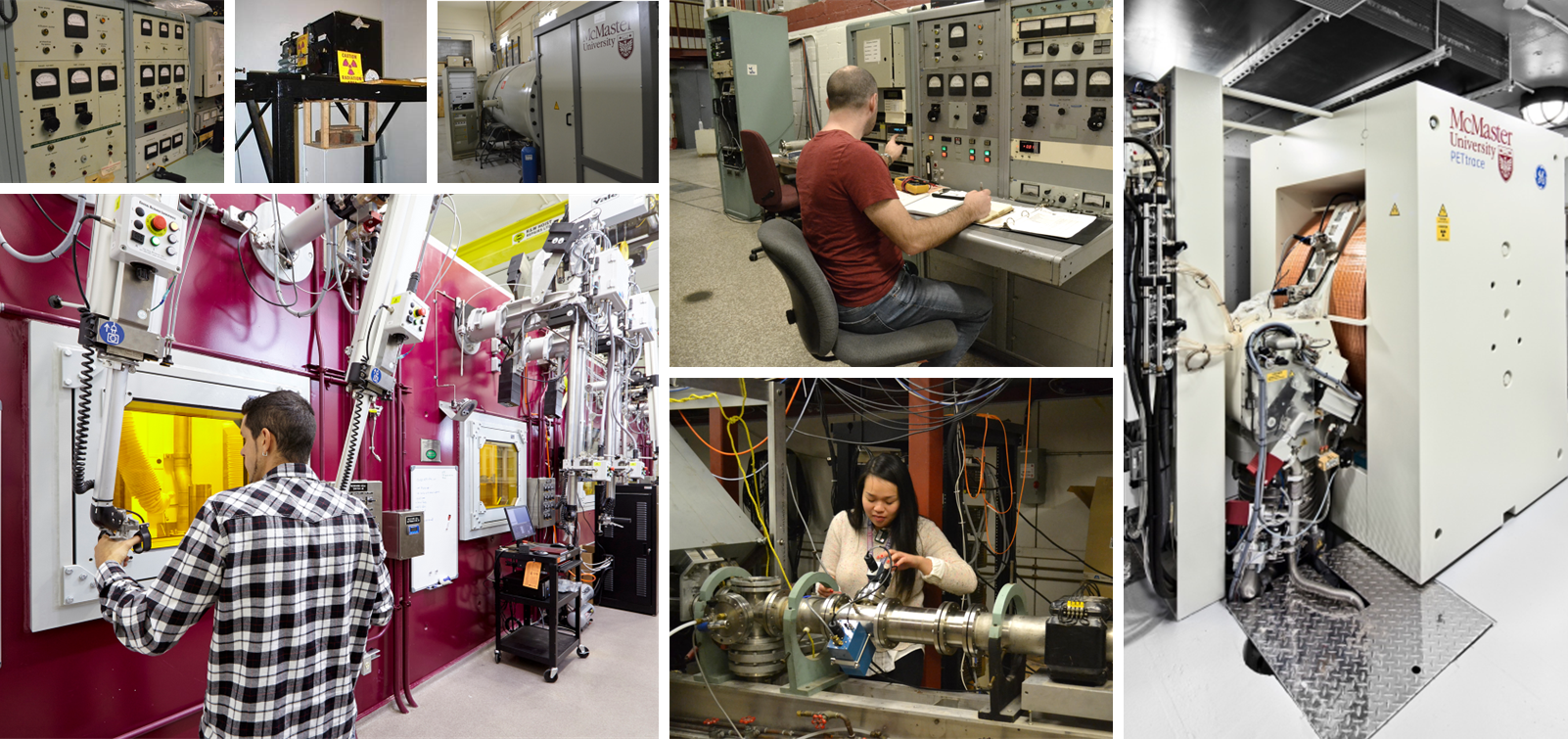Scott McMaster In Conversation: The McMaster Accelerator Laboratory

Scott McMaster is the manager of the McMaster Accelerator Laboratory, a suite of facilities located in the Tandem Accelerator Building (TAB) on the main McMaster University campus. Recently, NO&F scientist Matt Moran had a chance to sit down with Scott to get his perspectives on the facilities he manages and his experiences as both a worker and manager in the same facility. In the first part of this two-part interview, Scott provides an introduction to the research spaces he manages.
Let’s start with the McMaster Accelerator Laboratory. How many different research facilities does it house?
Currently MAL is home to four distinct facilities: the McMaster University Cyclotron Facility, the accelerators – the Model KN, Tandetron, and the microbeam Microprobe – the Taylor Source, and CANS, which stands for “Centre for Advanced Nuclear Systems.”
Could you elaborate a bit on each facility?
Certainly. The Taylor Source is cesium-137, purchased back in the late 1950s, probably from Chalk River, using money donated from the Taylor sisters. Hence the name. It was a two-kilocurie (2 kCi) source when it was purchased, and with a 30-year half life, it still has 500 Ci of activity. It has the advantage of being a stand-alone source that researchers can use to measure the response of materials and biological systems to radiation exposure.
The cyclotron is 16.5 MeV GE PETtrace instrument that McMaster acquired in 2009. It can accelerate protons and direct them at materials to create radioactive isotopes. The most common is fluorine-18, which is used in cancer imaging agents such as [18F]-fluorodeoxyglucose.
The accelerators provide different types of radiation for a variety of applications. The 3 MeV KN is a general-purpose instrument capable of producing proton, deuteron and alpha beams for irradiation of a wide variety of targets. The Tandetron is most often used as a neutron source, mainly for detector development and in-vivo neutron activation analysis. The Microprobe acts as a low-level radiation source of proton or alpha particles in a very focused beam for targeting cellular components.
Finally, CANS is our newest facility, commissioned in 2018 after ten years of work funding, designing, building and regulatory approvals. It consists of a suite of hot cells, which are large, enclosed work areas made of concrete and metal that shield the user from radiation while they can see through thick lead glass and work using manipulator arms. These cells can be used to safely handle up to 150 Ci of radioactivity for research and collaborative projects with the nuclear industry and other partners. Its main use (and primary design point) is doing post-irradiation examination of power reactor core components to determine their material properties after being in use for multiple decades.

What is one thing you wish more people knew about these facilities?
I don’t believe that a lot of people on campus appreciate how accessible these instruments are. McMaster provides some of the most open access to these facilities, provided you pass a rigorous screening and training process.
We allow access to graduate and undergraduate students to perform their own experiments, gaining crucial training and hands-on experience that will serve them well in their future careers.
Who uses these facilities? And what are some examples of the type of research being performed?
The facilities are very versatile and are used for all manner of interesting research projects. They draw scientists from all across campus, and even from other universities in Canada. The cyclotron is used to research and produce many radionuclides for applications like incorporation into radiopharmaceuticals. CANS is used mainly to determine the effects of long-term high radiation environments on nuclear reactor components. The KN has been used to irradiate teeth in order to observe if degradation can be tied to a person’s accumulated radiation dose. The Tandetron has been mainly used for occupational health research, looking at trace elements in the body non-invasively to better understand their biological effects. And, as I alluded to before, the Taylor Source is a great facility for measuring the effect of radiation doses on various organisms, including crickets, bed bugs…
What about societal relevance? You mentioned collaborative projects. How does facility research impact the broader community?
Oh, in many ways. Take the CANS facility. It was built in part to analyze pressure tubes from CANDU reactors, which generate over half of Ontario’s electricity. These pressure tubes were given an operational shelf life of 25 years, and cost $2 billion to replace per facility. If research on existing tubes can demonstrate that their shelf life is considerably longer, that would represent incredible savings for the nuclear industry, and for electricity users, while providing researchers with a wealth of experimental data on long-term exposure of these materials to radiation.
Any advice for people working in this field, or for the McMaster community at large?
BlogLook, whether it’s this facility or others like it on campus, take time to explore the different department web sites and see what’s available. Make a point to talk to the people that staff it. It’s easy to get stuck in a “one problem, one solution” mindset, when in fact the array of what McMaster has to offer can provide unique perspectives that could lead to some very rewarding, if not intuitive, answers.
